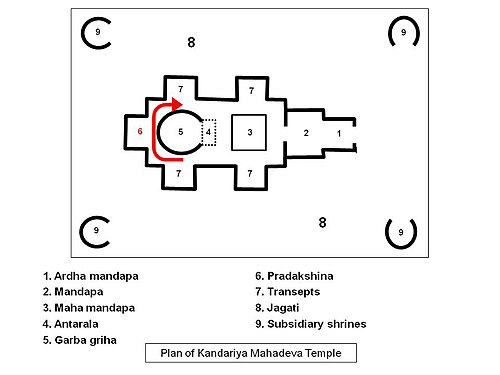Panchayatana (temple)

Layout in Hindu temple architecture
Hindu temples are built in the panchayatana (Sanskrit: पञ्चायतन, romanized: pañcāyatana) layout: the main shrine is surrounded by four subsidiary shrines.[1][2] The origin of the name are the Sanskrit words pancha (five) and ayatana (containing), referring to a "five-shrined" layout.[3][4]
Generally, Hindu temples are built along a west-east axis. The four subsidiary shrines are located at the north-east, south-east, south-west, and the north-west.
Examples of Panchayatana temples
- Shree Dev Vyadeshwar in Guhagar
- Kandariya Mahadeva Temple in Khajuraho
- Brahmeswara Temple in Bhubaneswar
- Jagdish Temple in Udaipur
- Lakshmana Temple in Khajuraho
- Lingaraja Temple in Bhubaneswar
- Arasavalli Temple near Srikakulam District of Andhra Pradesh near Visakhapatnam. Main shrine dedicated to Aditya. Subsidiary shrines dedicated to Ganesh, Shiva, Parvati and Vishnu.[5]
- Dashavatara Temple in Deogarh, Uttar Pradesh. It should be the oldest panchayatana temple in India.
- Nabaratna Temple in Pantchupi
- Shiva Panchayatana Temple in Tumbadi, Tumkur district. Subsidiary shrines dedicated to Lakshmi Narasimha, Vinayaka, Parvati and Surya.
- Gondeshvara temple, in Sinnar, Maharashtra[6]
- Panchayatan temple at Dronasagar, Kashipur, Uttarakhand is an archeological site, from 6th century AD.
- Rinmukteshwar Panchdevalaya, Ena situated in Ena Village of Surat district in Gujarat State.
References
- ^ "Khajuraho, India | World Heritage Site". The-world-heritage-sites.com. 1986-11-28. Archived from the original on 2014-03-17. Retrieved 2012-10-11.
- ^ Tadgell, Christopher (2015-10-23). The East: Buddhists, Hindus and the Sons of Heaven. Routledge. p. 889. ISBN 978-1-136-75384-8.
- ^ Asher, Frederick M. (2020-02-11). Sarnath: A Critical History of the Place Where Buddhism Began. Getty Publications. p. 59. ISBN 978-1-60606-638-6.
- ^ Dalal, Roshen (2014-04-18). The Religions of India: A Concise Guide to Nine Major Faiths. Penguin UK. p. 906. ISBN 978-81-8475-396-7.
- ^ "Suryanarayana Temple at Arasavalli". Templenet.com. Retrieved 2012-10-11.
- ^ "Archived copy" (PDF). Archived from the original (PDF) on 2016-03-03. Retrieved 2012-10-30.
{{cite web}}: CS1 maint: archived copy as title (link)
- v
- t
- e










